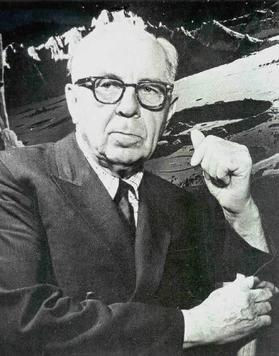A titanic talent
- James Tyler
- Sep 21, 2023
- 3 min read
Updated: Sep 21, 2023
Go out on a clear night and if your timing is right, you’ll see the Moon just past being new, a bright fingernail shape low on the horizon. It’s a beautiful sight.

But what if you could be out walking and hanging low on your horizon was the planet Saturn, also partially illuminated with its famous rings seen edge on and faintly lighted? Maybe you could if you were on Titan, one of its many satellites?
Chesley Bonestell saw just such an awesome image – in his imagination. Thankfully, he was an extremely talented artist and brought that vista to life.

In 1944, he created the painting “Saturn as Seen from Titan,” which would be published in “Life” magazine.
This was long before the Space Race between the United States and the Soviet Union, but that image has been called “the painting that launched a thousand careers.”
Bonestell’s impact on space research, exploration and development can’t be underestimated.

In the early 1950s, not long before Russia got things running with the launch of its first artificial satellite named Sputnik, “Colliers” magazine ran a series of features called “Man Will Conquer Space Soon!,” which detailed Wernher von Braun’s concepts for the exploration of space.
Bonestell’s art brought those ideas of living and working in space to life and really ginned up America’s enthusiasm for doing so.
Bonestell lived for 98 years, having been born in 1888 and dying in 1986. His birthday was on Jan. 1, which seems very appropriate. All his life people would celebrate his birth date as a time for renewal and looking to the future.
And that was a wild century he lived through – from horse-drawn buggies to the Wright brothers’ first machine-powered flight to astronauts exploring the Moon on foot and with a new type of buggy to men living and working in space for days during the Space Shuttle program.

Back before humans reached into space with Sputnik, Apollo, Voyager, the Space Shuttle, the ISS, Mars rovers, Shenzhou, DragonX and on to Artemis, Bonestell was already there with his dynamic depictions of other-wordly sights.
Check out some of his amazing images at www.bonestell.org.
Did he get it all right? No, Titan is covered by methane so you probably can’t see the lovely view of Saturn as he painted it, for instance. Sad, but it doesn’t make his painting any less beautiful and inspiring.
He’s been called “The Father of Space Art,” and his creations have been collected in several books, such as “A Chesley Bonestell Space Art Chronology” by Melvin H. Schuetz and “The Art of Chesley Bonestell” by Ron Miller.
His paintings are exhibited in various places, including the Smithsonian’s National Air and Space Museum in Washington, D.C.

A 2019 documentary called “Chesley Bonestell: A Brush with the Future” highlighted the artist’s life, work and impact on science and space exploration. Here’s a preview you can see: Chesley Bonestell: A Brush With The Future - Trailer - YouTube.
As a member of the Planetary Society and the National Space Society, I enjoy the latest in space art created by very talented men and women from around the world.

Their work helps to illustrate new programs, research, speculations and hopeful explorations of space and other worlds.
They’ve picked up that inspirational brush Bonestell wielded so expertly long ago and maybe will launch thousands of more careers in science and technology.
And who knows, someday the methane clouds of Titan will part briefly and someone will really be there to see Saturn hanging low and beautiful on the horizon in person.
But for now, we have Bonestell’s inspiring vision.



Commenti